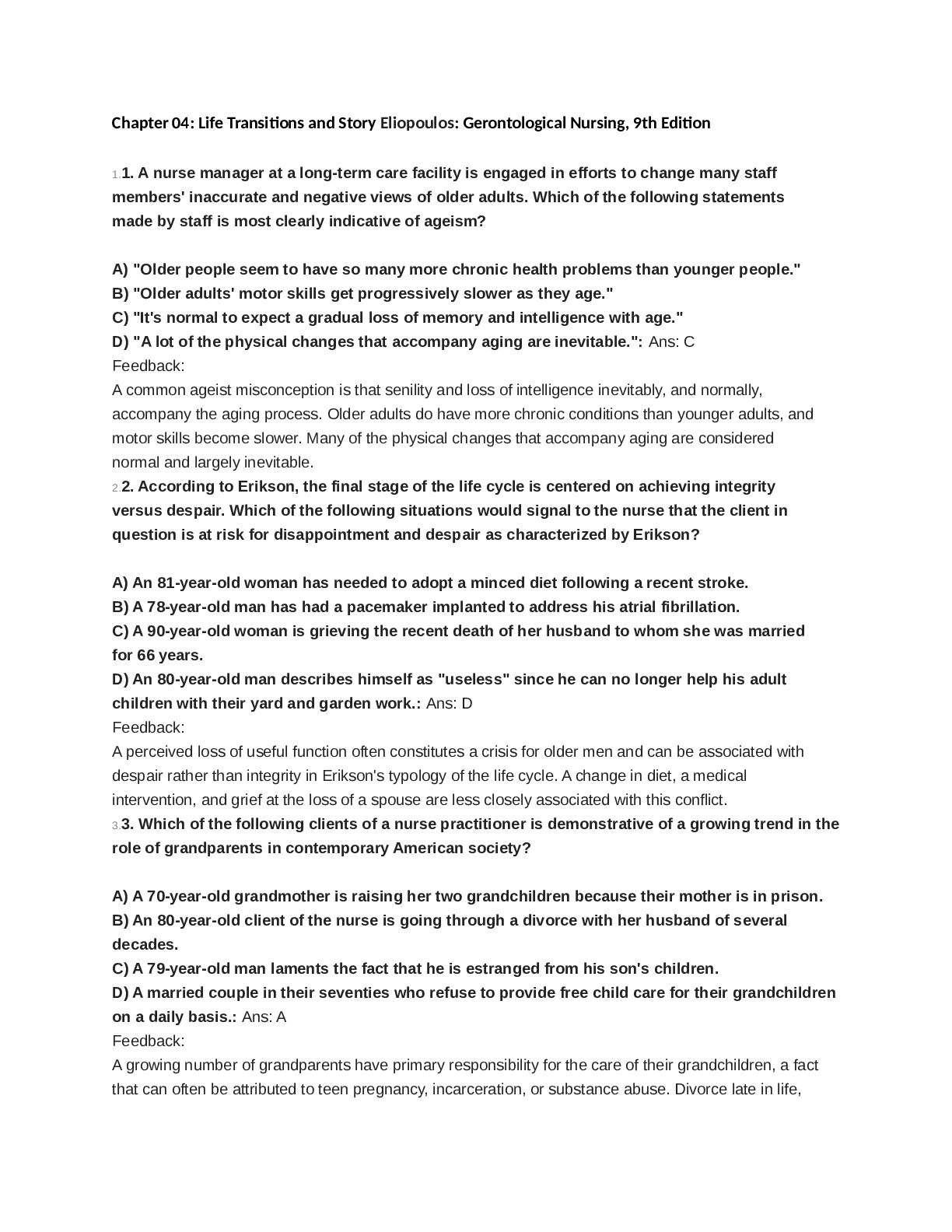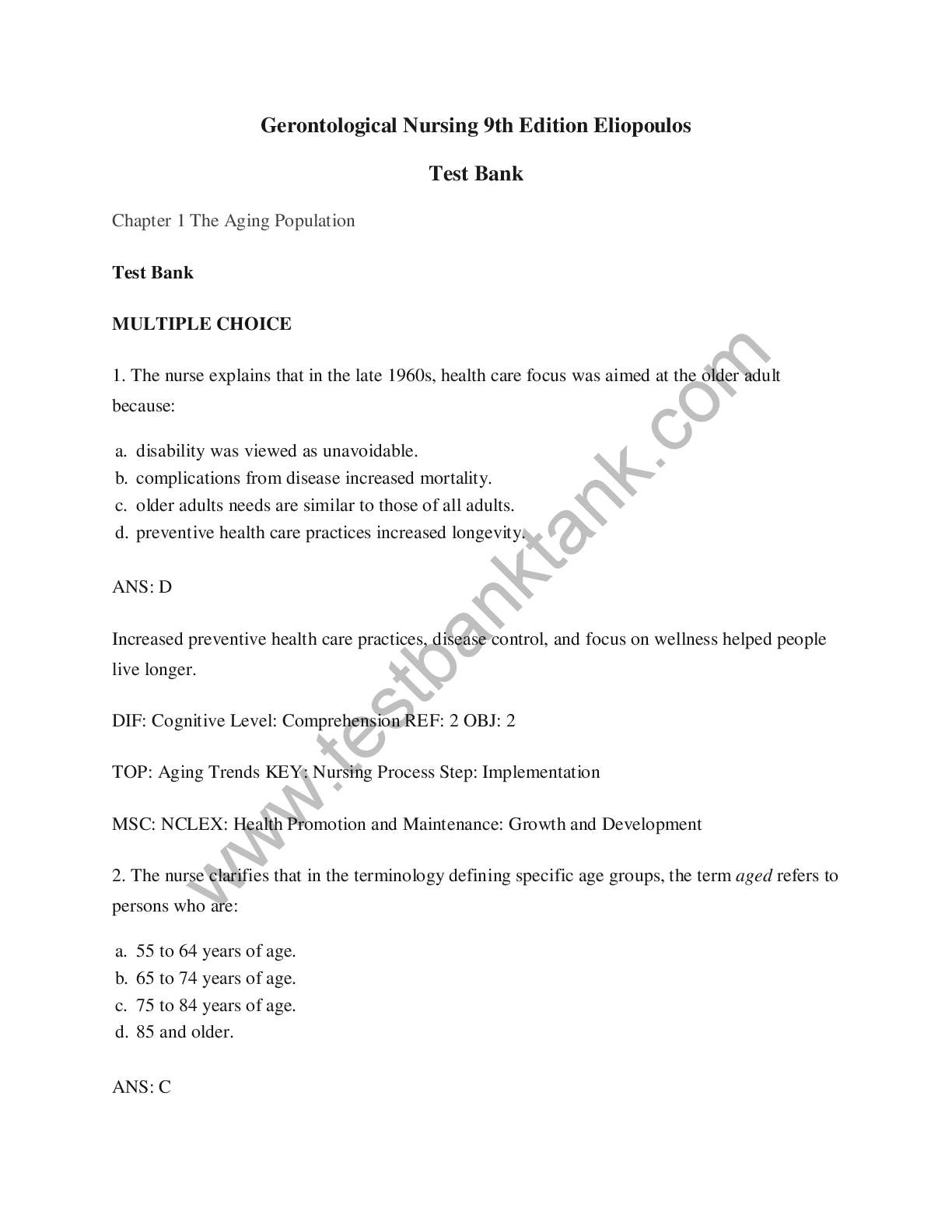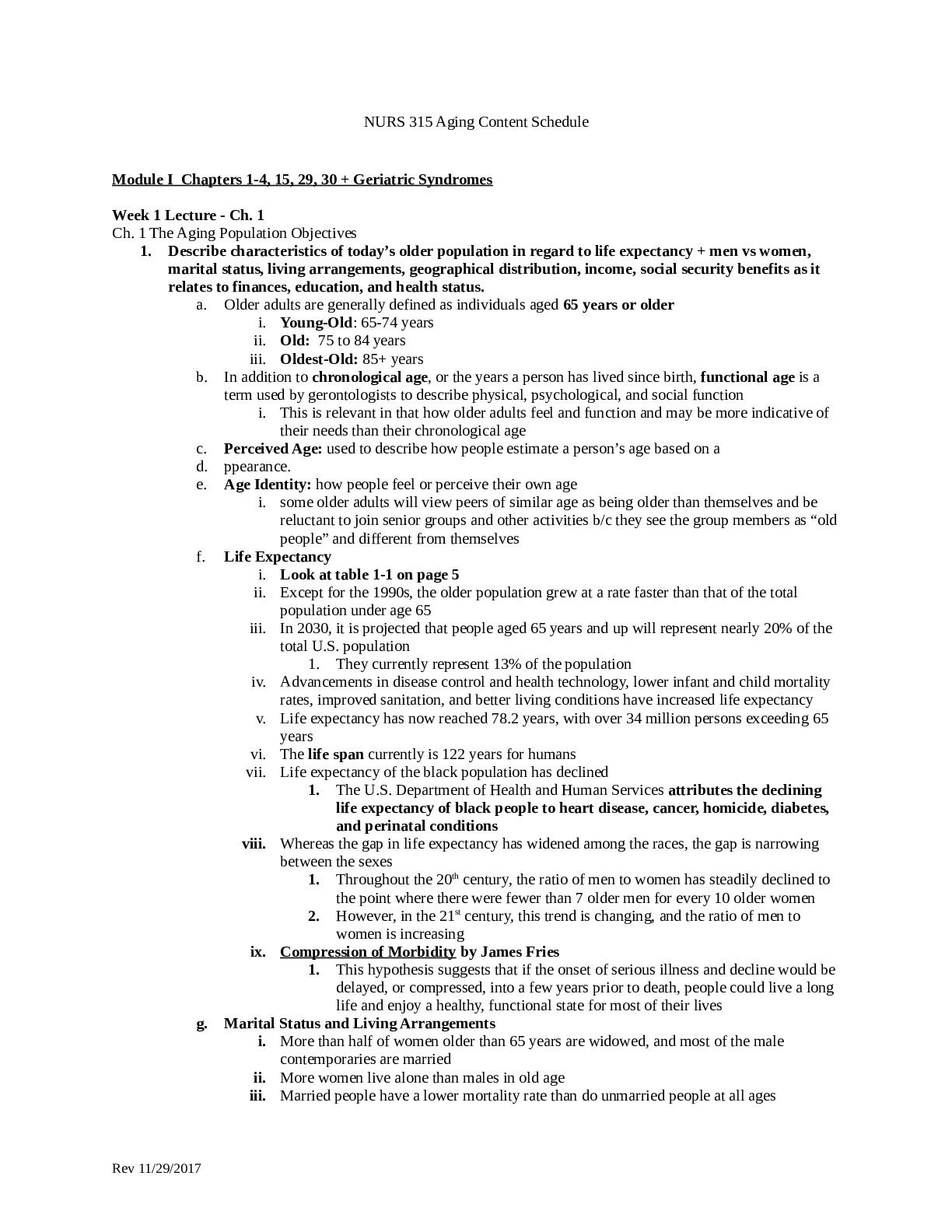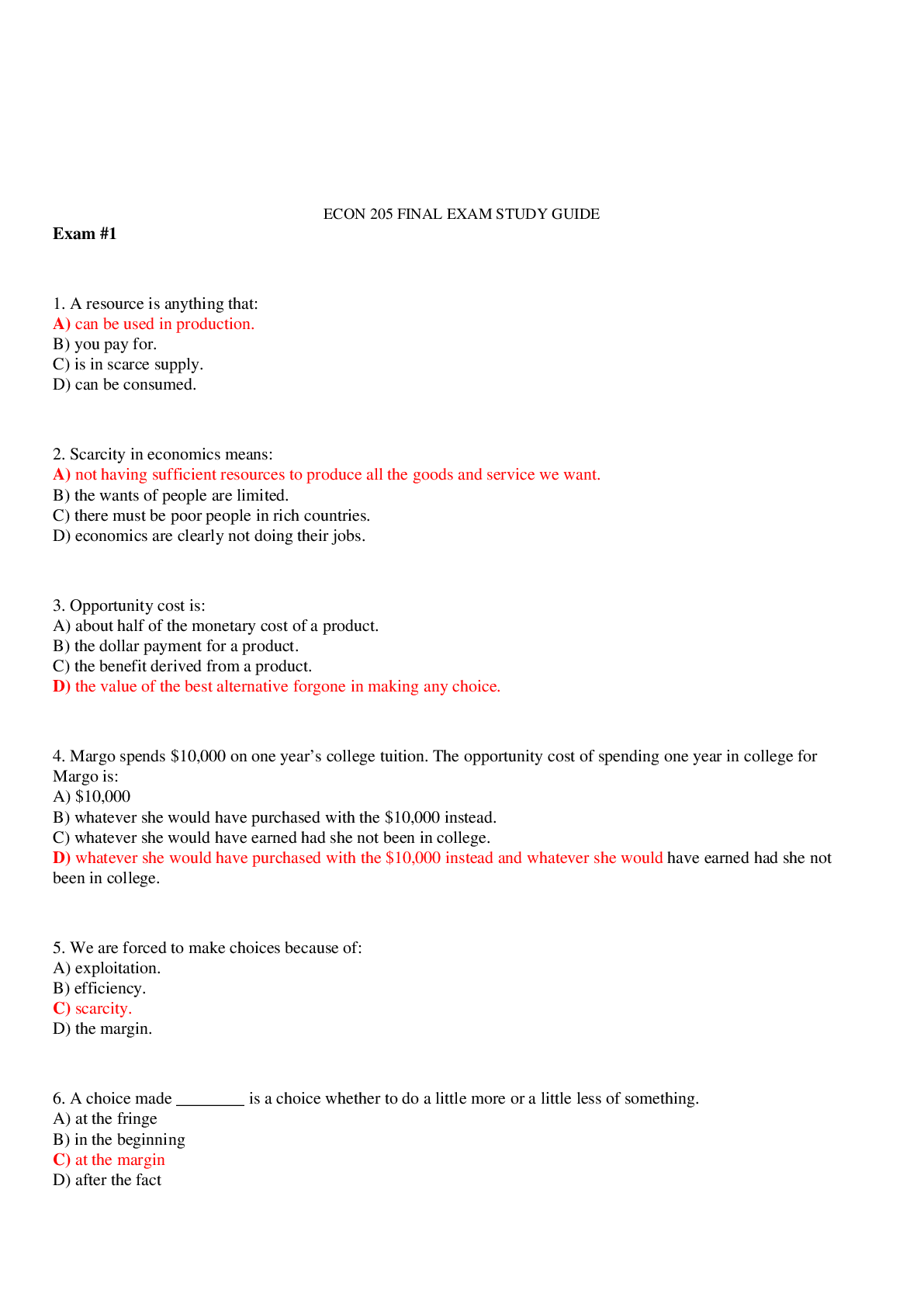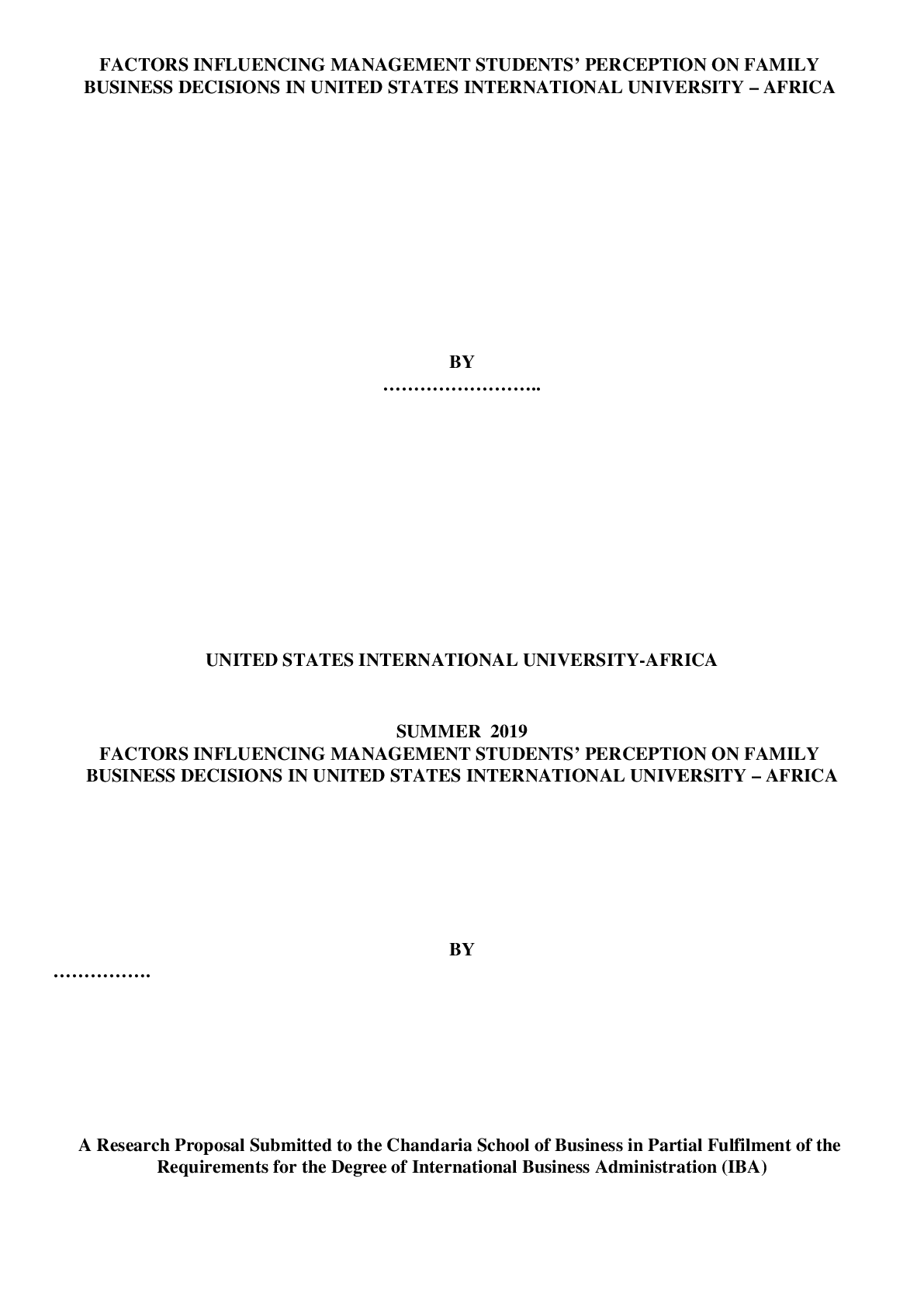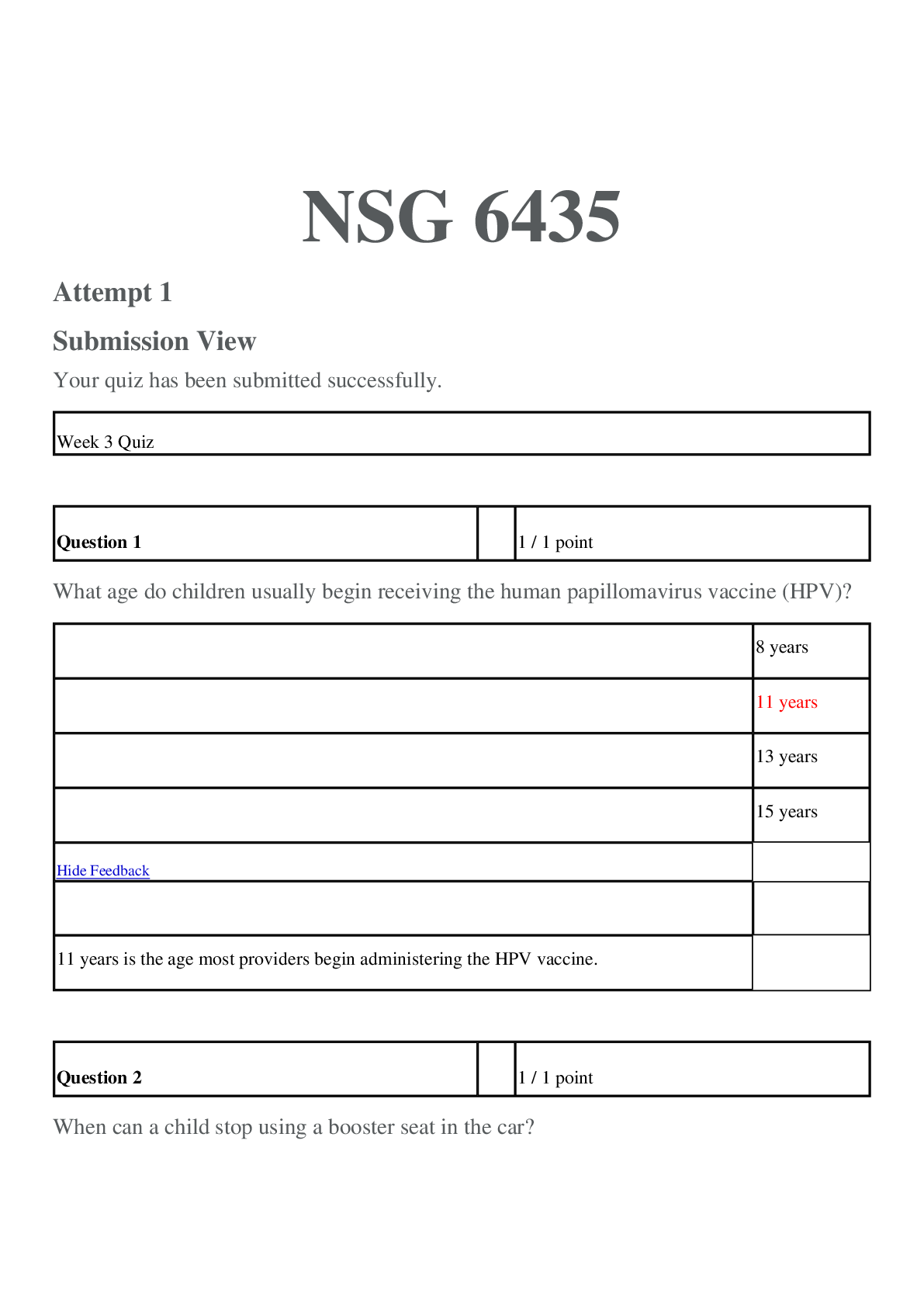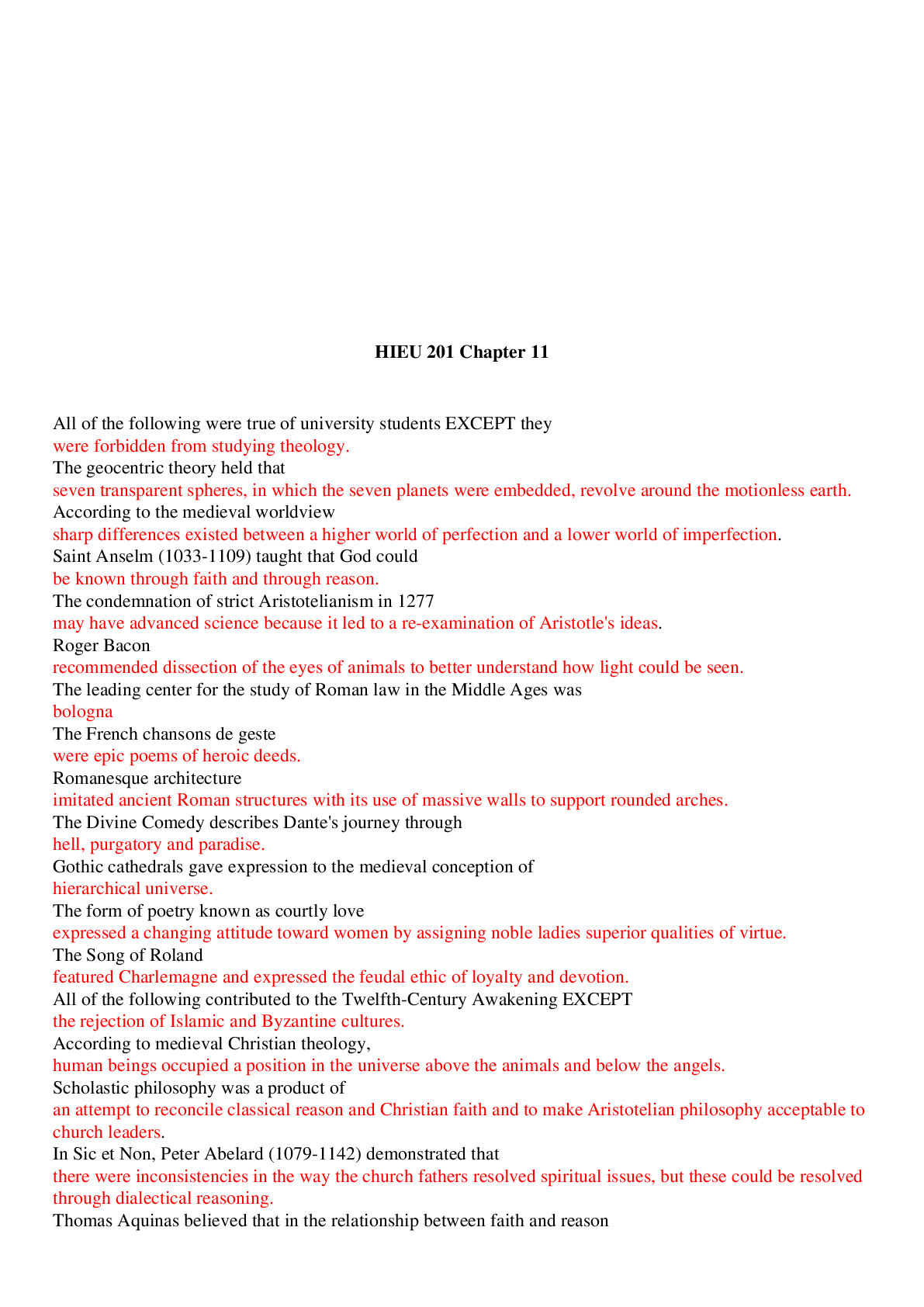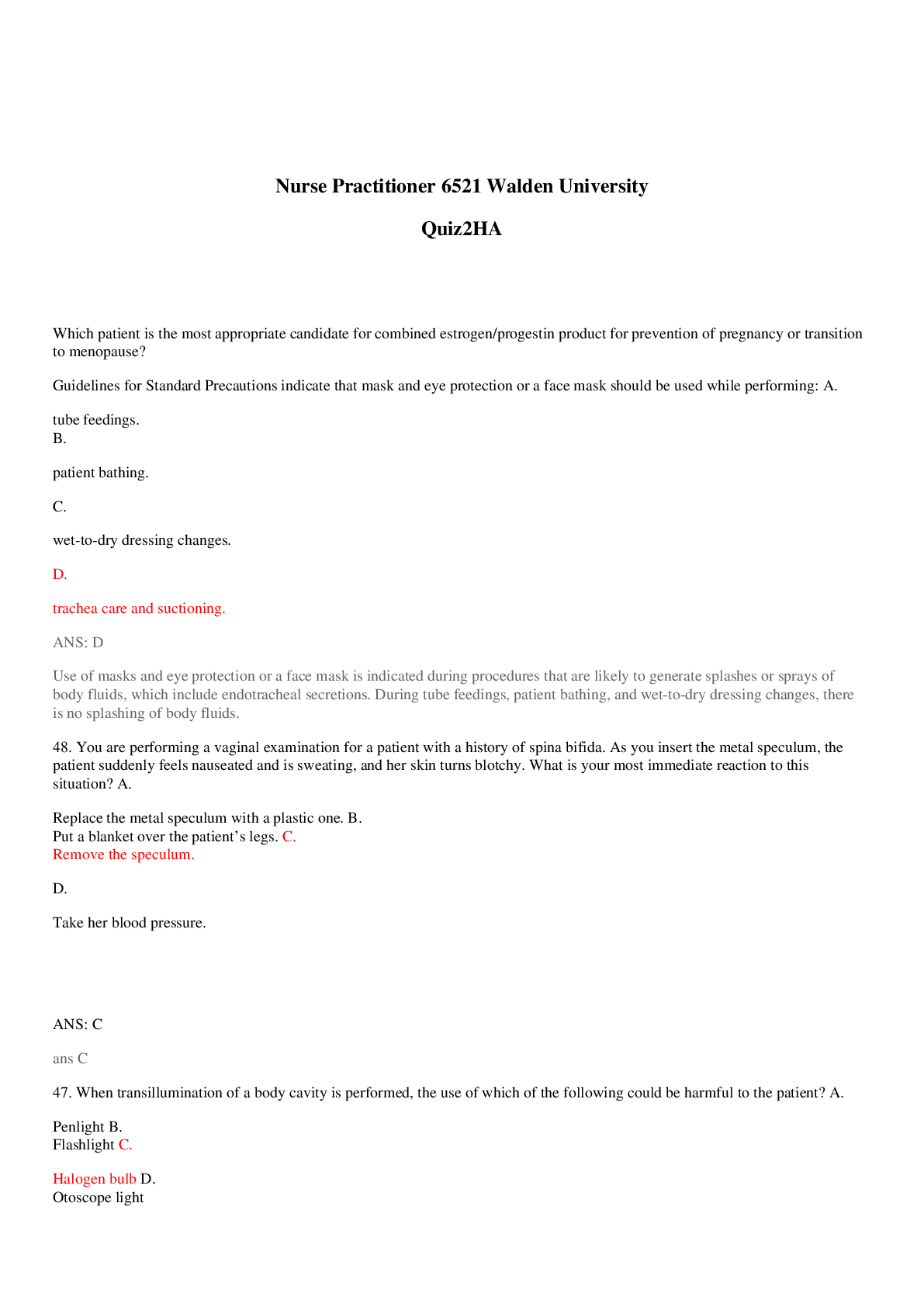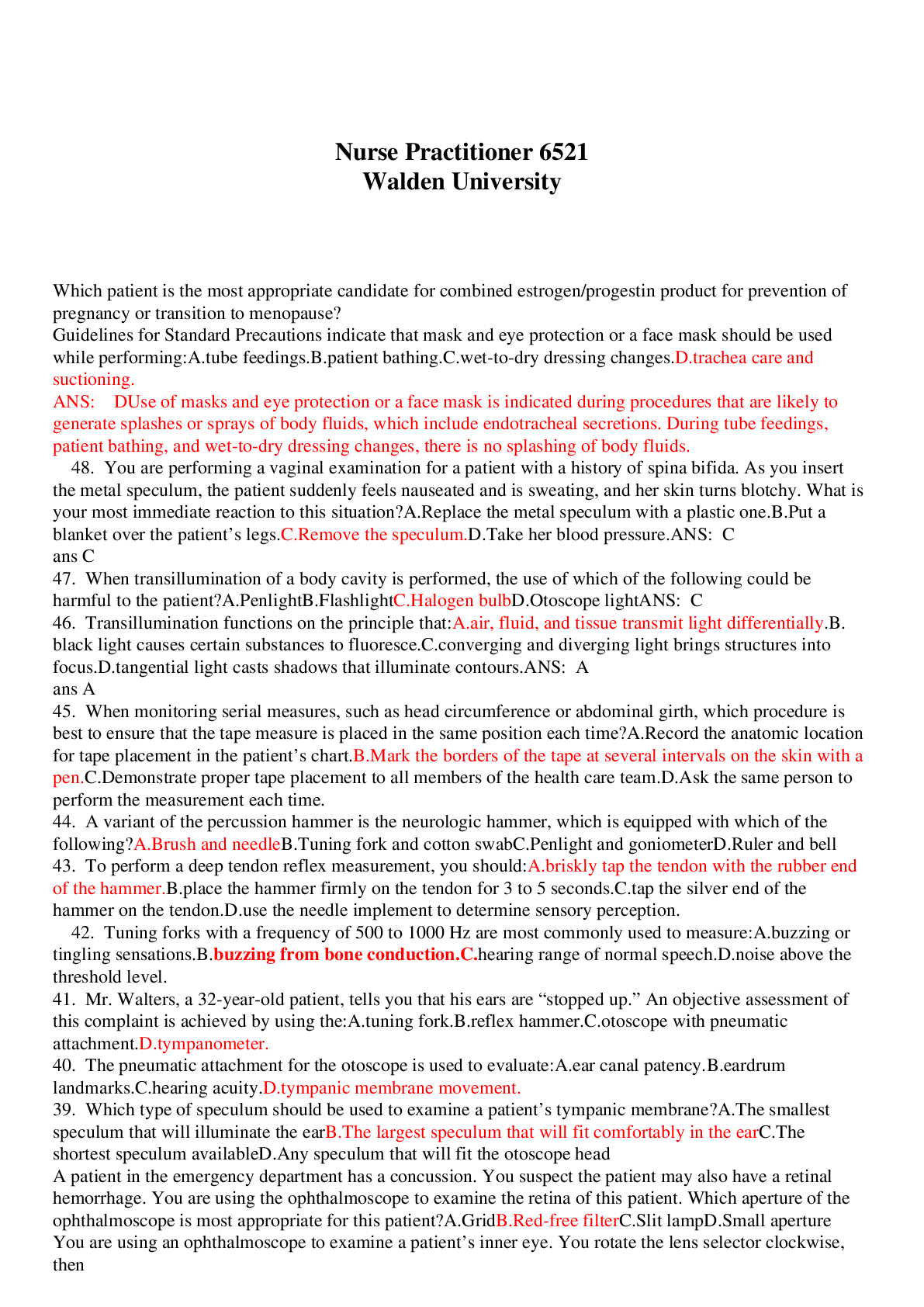Lewis 18, 19, 20
Document Content and Description Below
Lewis 18, 19, 20 Chapter 18: Surgery: the art and science of treating diseases, injuries, and deformities by operation and instrumentation; involves multidisciplinary interaction among the patient... , surgeon, anesthesia care provider (ACP), nurse, and other health care team members as needed Surgery may be performed for: Elective surgery= planned, emergency surgery= unexpected urgency Same-day admission: admitted on day of surgery, typically for inpatient surgery (patients there before surgery typically for acute/chronic medical conditions) Ambulatory surgery: same-day, outpatient; minimally invasive techniques; can be performed in endoscopy clinics, physicians’ offices, freestanding surgical clinics, and outpatient surgery in the hospital; use general, regional, or local anesthetic; operating time of less than two hours; require less than 24-hour post-op stay Preoperative interview: obtain the patient’s health information, provide and clarify information about the planned surgery (including anesthesia), and assess the patient’s emotional state and readiness for surgery (including expectations about outcomes); provides patient and caregiver an opportunity to ask questions about the surgery, anesthesia, and postoperative care Overall goal of preoperative assessment: identify risk factors and plan care to ensure patient safety throughout the surgical experience Nurse’s role in psychologically preparing patient for surgery is to assess the patient for potential stressors that could negatively affect surgery: Most common psychologic factors: Allergies: question patient about drug intolerances and allergies—usually results in side effects that are uncomfortable or unpleasant for the patient but are not life threatening (nausea, constipation, diarrhea, idiosyncratic reactions) Last component of patient history: body systems review—current medical problems can alert you to areas that should be more closely examined in the preoperative physical exam Physical exam: required for all patients admitted to the OR (H&P); in advance or on day of surgery (P1= normal healthy person, P2= patient with mild systemic disease, P3= patient with severe systemic disease, P4= patient with severe systemic disease that is a constant threat to life, P5= moribund patient who is not expected to survive without surgery; P6= declared brain-dead patient whose organs are being removed for donor purposes) Laboratory and diagnostic testing: preoperative tests ideally ordered based on patient’s H&P; may be done days before surgery; missing reports may result in delay/cancellation of surgery Preoperative nursing interventions are derived from nursing assessment and must reflect each patient’s specific needs Preoperative teaching: patient has a right to know what to expect and how to participate effectively during surgical experience • Increases patient satisfaction and reduces postoperative fear, anxiety, and stress • Decrease development of complications, length of hospitalization, and recovery time after discharge • Balance between explaining too much (patient overwhelmed) and telling too little (patient unprepared)—anxiety and fear may decrease learning ability • Teaching typically includes three types of information: o Sensory: patients find out what they will see, hear, smell, and feel during surgery (lights are bright, etc.) o Process: general flow of what is going to happen (ex: patient’s transfer to holding area) o Procedural: patients desire details that are more specific (ex: this will include an IV line) General surgery information: patients should receive instruction about deep breathing, coughing, and early ambulation postoperatively (except craniotomy, tonsillectomy); patients should understand how to rate their pain Ambulatory surgery information: patient needs to receive information before admission; traditionally, patients having elective surgery are instructed NPO at midnight before the surgery; restriction of fluids and food is designed to reduce the risk of pulmonary aspiration and postoperative nausea and vomiting; protocols may vary for patients having local anesthesia or surgery scheduled later in the day Legal preparation: surgical consent forms, advance directives, durable power of attorney for health care • Consent for surgery: active, shared decision-making process between health care provider and recipient of care; must be adequate disclosure of diagnosis (nature/purpose of treatment, risks/consequences of treatment, probability of successful outcome; prognosis without treatment), clear understanding of information being provided, and voluntary consent (must not be persuaded or coerced in anyway by anyone to undergo procedure) Minimum fasting period: clear liquids (2 hours pre-op), breast milk (4 hours pre-op), nonhuman milk/infant formula (6 hours pre-op), light meal- toast/clear liquids (6 hours pre-op), meal (8 or more hours pre-op) True medical emergency may override the need to obtain consent Day of surgery prep: • Nursing role: final preoperative teaching, assessment, and communication of findings; ensure that all preoperative orders are done and that chart is complete and accompanies patient to OR; place identification band and allergy band; return patient valuables to caregiver • Preoperative medications: benzodiazepines used for sedative and amnesic properties; anticholinergics used to reduce secretions; opioids given to decrease pain and intraoperative anesthesia; antiemetics given to decrease N/V; others include antibiotics, eyedrops, and routine prescriptions; beta-blockers sometimes used in patients with hypertension or coronary artery disease to control BP or reduce heart attack/cardiac arrest risk Chapter 19 Surgical suite: controlled environment designed to minimize spread of pathogens and allow a smooth flow of patients, staff, and equipment needed to provide safe patient care; divided into three distinct areas: • Unrestricted area: people in street clothes can interact with those in surgical attire (ex: holding area, locker rooms, nursing station) • Semi-restricted area: surrounding support areas and corridors; only authorized staff are allowed access; must wear surgical attire and cover all head and facial hair • Restricted area: masks are required to supplement surgical attire; can include OR, scrub sink area, clean core Holding area: preoperative holding area; special waiting area inside of or adjacent to surgical suite; area where you identify and assess patient before transferring to OR; another area for holding is admission, observation, and discharge area (AOD)—allow early-morning admission for outpatient surgery, same-day admission, and inpatient holding before surgery, can assess preoperative information, observe the patient both before and after surgery, and allow sufficient time before patient is discharged to home or inpatient room Operating room: controlled geographically, environmentally, and bacteriologically; restricted in terms of inflow and outflow of staff; filters and controlled airflow in vent systems provide dust control; positive air pressure in the rooms prevents air from halls/corridors from entering OR; UV lighting may be used because UV radiation reduces number of microorganisms in air; dust-collecting surfaces are omitted; materials used that are resistant to corroding effects of strong disinfectants Surgical team: • Registered nurse o Perioperative nurse: implements patient care during perioperative procedure; prepare OR for patients before they arrive; patient’s advocate throughout the intraoperative experience (maintain safety, privacy, dignity, and confidentiality); ongoing assessment is essential because patient’s condition may change quickly—respond to changes and revise care plan as needed ▪ Scrub nurse: follow designated scrub procedure, gowned and gloved in sterile attire, remain in sterile field ▪ Circulating nurse: remain in unsterile field so you are not gowned and gloved in sterile attire o Certified operating room nurse (CNOR): reflects expertise in surgical nursing; personal commitment to higher standards • Licensed practical/vocational nurse and surgical technologist o Could take the place of perioperative nurse o Must have access to an RN at all times • Surgeon and assistant o Surgeon: physician who performs the surgical procedure; primarily responsible for: ▪ Preoperative medical history and physical assessment ▪ Patient safety and management in OR ▪ Postoperative management of patient o Assistant: physician who functions in an assisting role; usually holds retractors to expose surgical areas and assists with hemostasis and suturing; may perform some portions of surgery under surgeon’s supervision • Registered nurse first assistant (RNFA) o Work collaboratively with surgeon, patient, and surgical team by handling tissue, using instruments, providing exposure to surgical site, assisting with hemostasis, and suturing • Anesthesia care provider (ACP) o Monitors anesthesia and can be an anesthesiologist, nurse anesthetist, or anesthesiologist assistant (AA) o Anesthesiology—medically manage unconscious patients, protect functions and vital organs, manage pain, manage CPR, manage problems in pulmonary care, manage critically ill patients in special care units Nursing management: patient before surgery—establishes baseline data for intraoperative and postoperative care • Psychosocial assessment • Physical assessment: thorough physical assessment during preoperative preparation of patient • Chart review: contributes to an understanding of past/present history, cardiopulmonary status, and potential for infections/complications • Admitting the patient: initial greeting, extension of human contact/warmth, proper identification; CAM therapies may be used to decrease anxiety, promote relaxation, reduce pain, accelerate healing process; admitting procedure continued with reassessment of patient and time for last-minute questions Nursing management: patient during surgery • Room preparation: ensure privacy, prevention of infection, and safety; surgical attire is worn by all people entering the OR; electrical and mechanical equipment is checked for proper functioning; aseptic technique is practiced; scrub nurse is in sterile field; circulating nurse is in unsterile field Transferring patient • Transported to room for surgery; once patient is in OR bed, place safety straps snugly across patient’s thighs; monitor leads, BP cuff, and pulse oximeter are usually applied and IV catheter is inserted Scrubbing, gowning, and gloving • Surgical hand antisepsis—fingers and hands scrubbed first with progression to forearms and elbows • Hands held away fro surgical attire and higher than elbows at all times to prevent contamination • Prewash hands and arms before applying alcohol-based product (if applicable) • After hand antisepsis is completed, team members enter OR and put on gowns and two pairs of gloves Basic aseptic technique • Prevent infection • Creation/maintenance of sterile field (center of sterile field is site of surgical incision) • Guidelines by OSHA emphasize standard and transmission-based precautions Assisting anesthesia care provider • If patient has general anesthetic, remain at patient’s side to ensure safety and to assist the ACP • May include measuring BP and assisting in maintenance of patient’s airway Safety considerations • Universal Protocol used to prevent wrong site, wrong procedure, and wrong surgery (WHO safety checklist) • Surgical time-out before procedure starts to verify patient identification, surgical procedure, and surgical site Positioning patient • Usually follows admission of anesthetic • Allow for accessibility to operative site, administration and monitoring of anesthetic agents, and maintenance of patient’s airway • Provide correct musculoskeletal alignment, prevent undue pressure on nerves/skin over bony prominences/earlobes/eyes, provide for adequate thoracic excursion, prevent occlusion of arteries and veins, provide modesty in exposure, and recognize and respect individual needs (aches, pains, deformities) • Supine position: abdomen, heart, breast • Prone: back • Lithotomy: pelvic organ surgery Preventing hypothermia • Correlation between hypothermia and impaired wound healing, adverse cardiac events, altered drug metabolism, and coagulopathies • Prevent: closely monitor temperature and apply thermal warming blanket if needed Preparing surgical site • Skin preparation, “prepping,” reduces number of microorganisms available to migrate to surgical wound • Skin mechanically scrubbed or cleansed around surgical site with antimicrobial agent • After skin is prepped, sterile members of team drape the area—only surgical site is left exposed Patient after surgery • Accompany patient to PACU • Handoff includes patient status and procedure performed; promote safe, ongoing care Factors contributing to patient anesthetic choice (ultimate choice made by APC): physical and mental status, allergy and pain history, expertise of the ACP, and factors relating to the operative procedure Monitored anesthesia care (MAC): used for diagnostic or therapeutic procedures performed in or outside of the OR; includes varying levels of sedation, analgesia, and management of any physiologic problems that may develop; patients less responsive and may require airway management; often used in conjunction with regional or local anesthesia Moderate sedation: performed outside of the OR (ex: reduction of dislocated joints in ER); does not require presence of an ACP; patients responsive and can breathe without assistance; minor therapeutic procedures General anesthesia: technique of choice for patients who are having surgical procedures that are of significant duration, require skeletal muscle relaxation, require uncomfortable operative positions, or require control of ventilation; may be induced by IV or inhalation; balanced technique using adjunctive drugs to complement induction • Intravenous agents: induce pleasant sleep with rapid onset of action that patients find desirable; once done, ACP uses selected inhalation and IV Agents; total intravenous anesthesia (TIVA) becoming more frequent • Inhalation agents: enter body through alveoli in lungs; ease of administration and rapid excretion by ventilation make them desirable agents • Loss of sensation with loss of consciousness; elimination of coughing, gagging, vomiting, and sympathetic nervous system responses • Dissociative anesthesia: interrupts associative brain pathways while blocking sensory pathways Local anesthesia: interrupts generation of nerve impulses by altering the flow of sodium into nerve cells through cell membranes; blocks autonomic then somatic then somatic motor impulses; loss of sensation without loss of consciousness; induced topically or via infiltration, intracutaneously, or subcutaneously Regional anesthesia: injected and involves a central nerve or group of nerves that innervate a site remote to the point of injection; loss of sensation to a region of body without loss of consciousness; involves blocking a specific nerve or group of nerves with administration of local anesthetic Local and regional: rapid recovery and discharge Local anesthetics are injected at the surgical site, nebulized, or applied topically Regional anesthesia: • Spinal anesthesia: injection of a local anesthetic into cerebrospinal fluid found in subarachnoid space, usually below L2 • Epidural block: injection of a local anesthetic into the epidural space via thoracic or lumbar approach; sensory pathways are blocked but motor fibers remain intact Anaphylaxis: most severe form of allergic reaction; life-threatening pulmonary and circulatory complications Malignant hyperthermia: hyperthermia with rigidity of skeletal muscles that can result in death; Succinylcholine appears to be main trigger; other factors include stress, trauma, and heat; usually occurs during general anesthesia but can occur in recovery period; autosomal dominant trait—hypermetabolism of skeletal muscle resulting from altered control of intracellular calcium Chapter 20 Patient’s immediate recovery is managed in a post-anesthesia care unit (PACU) Phases of postanesthesia care: • Phase I o Care during immediate postanesthesia period o ECG and more intense monitoring o Goal: prepare patient for transfer to phase II or inpatient unit • Phase II o Ambulatory surgery patients o Goal: prepare patient for transfer to extended observation, home, or extended care facility • Extended observation o Extended care or observation unit o Goal: prepare patient for self-care Initial PACU assessment • Airway o Patency o Oral/nasal airway o Laryngeal mask airway o Endotracheal tube • Breathing o Respiratory rate and quality o Auscultated breath sounds o Pulse oximetry o Supplemental O2 • Circulation o ECG monitoring- rate and rhythm o Blood pressure o Temperature o Capillary refill o Color and temperature of skin o Peripheral pulses • Neurologic o Level of consciousness o Orientation o Sensory and motor status o Pupil size and reaction • Gastrointestinal o Nausea and vomiting o Fluid intake • Surgical site o Dressings o Drainage • Pain o Incision o Other Respiratory problems: • Airway obstruction: commonly caused by blockage of the airway by patient’s tongue • Hypoxemia: partial pressure of arterial oxygen less than 60 mm Hg; variety of nonspecific clinical signs and symptoms (agitation to somnolence to hypertension to tachycardia) • Atelectasis: alveolar collapse; result of bronchial obstruction caused by retained secretions or decreased respiratory excursion Cardiovascular problems: • Hypotension: signs of hypoperfusion to the vital organs, especially the brain, heart, and kidneys; clinical signs of disorientation, loss of consciousness, chest pain, and oliguria reflect hypoperfusion (most common: unreplaced fluids and blood loss) • [Show More]
Last updated: 1 year ago
Preview 1 out of 10 pages
Instant download
.png)
Buy this document to get the full access instantly
Instant Download Access after purchase
Add to cartInstant download
Reviews( 0 )
Document information
Connected school, study & course
About the document
Uploaded On
Jul 30, 2021
Number of pages
10
Written in
Additional information
This document has been written for:
Uploaded
Jul 30, 2021
Downloads
0
Views
37



